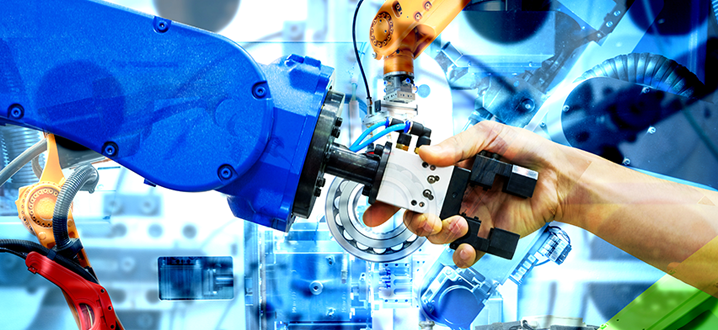Manufacturing Innovation Blog
Powered by the Manufacturing Extension Partnership

Robots have been a part of industry longer than you might think. The patent for the first industrial robot, Unimate, was granted in 1961. While robots were sometimes utilized by larger manufacturers, such as automotive original equipment manufacturers (OEMs), they were rarely an option for small and medium-sized manufacturers (SMMs).
However, times have changed. Robots are now often viewed as essential tools for SMMs, enabling smaller operations to compete with larger players. This is especially the case with the new wave of “collaborative robots.” According to the Robotics Industries Association, a collaborative robot, also known as a “cobot”, is specifically designed to work directly with humans, side-by-side, within a defined collaborative workspace.
What Do Cobots Offer Manufacturers?
For every busy manufacturing employee wishing they had an extra arm, collaborative robots can provide high-tech arms with cameras and motion sensors, designed with different reaches and payloads. Unlike traditional “autonomous” one-job machines, collaborative robot technology can mimic multiple hand-arm movements required for repetitive tasks such as inspecting small auto parts or wheel hub assemblies.
Collaborative robots can be used to free employees from repetitive tasks so they can focus on tasks that require more advanced skills. For example, three people who previously focused their time on inspecting a single bin can now be assigned to jobs like driving a forklift, according to Brian Pelke, president of Kay Manufacturing in Calumet City, Illinois. “We want them to use their brains more than their hands,” Pelke said.
Pelke recently touted the many ROI benefits of collaborative robots in a Chicago Tribune article. Pelke purchased his first collaborative robot for less than $50,000 and had it fully operational within 30 days. It took employees less than 90 minutes to complete the basic programming tutorial.
Pelke states cobots have saved Kay about $150,000 in packing costs by shifting machine operator duties away from packaging completed parts. Pelke noted the machines can consistently detect visual defects in auto parts, whereas humans — who may become tired or distracted — only catch the defects 9 times out of 10.
Another benefit of cobots is their mobility, which lets them adapt to almost any workspace. Most of the machines weigh well-under 80 pounds and have a footprint of mere inches. They require far less power to operate than traditional robots and can be redeployed for multiple applications without changing production layouts. Ideal for small jobs and quick changeovers, cobots perform
recurrent tasks at very high levels of consistency.
What the Future Holds When It Comes to Collaborative Robots
Collective robot sales are expected to grow 34 percent by 2026, with global robotic spending estimated to reach $13 billion, according to the Tribune article. And the Robotic Industries Association recently reported a record number of robots were shipped to North American companies in the first quarter of 2018.
But cobots only represent three percent of robot sales currently, as reported in the Tribune article, possibly due to the fact the collaborative robot technology is still very much an emerging field.
Formal safety standards for robots were only inaugurated in 2016 when the International Organization of Standardization (ISO) published ISO Technical Specification (TS) 15066. The American National Standards Institute (ANSI) adopted ISO/TS 15066 that same year as ANSI/RIA Technical Report R15.606 (RIA is the Robotic Industries Association).
According to these standards, robots are determined to be “safe” if there is adequate distance between people and the active machines, and if there are limitations for the transfer of forces and pressure, should contact occur.
These safety guidelines provide an excellent starting point for further research, according to the National Institute of Standards and Technology (NIST), an agency of of the U.S. Department of Commerce that uses science to advance innovation for U.S. manufacturers. In addition to ongoing research into collaborative robot safety, NIST is conducting two research initiatives related to the intricacies of humans working side-by-side with robots and cobots, which promise major gains when it comes to both safety and productivity, according to Elena Messina, Program Manager, Measurement Science for Manufacturing Robotics at NIST.
1. Visibility
Many cobots have built-in cameras that allow them to perceive their surrounding environment. For them to work properly, there has to be an interface between the camera coordinate system and the robot coordinate system. Per Messina, NIST is working on creating tools to enhance this coordination by asking questions like, “Has the robot shifted from where it thinks it is?” and “Is the coordinate system aligning with actual surroundings?”
NIST’s research into robot visibility also takes a closer look at cameras and algorithms that can be used to detect and track humans, which promise to improve safety and general human-robot interaction.
2. Programming
It’s not difficult to program cobots to perform most manufacturing tasks, but it could be even easier. And the easier it is, the fewer opportunities there are for human-introduced errors, which can lead to safety issues and production problems. To this end, NIST is currently prototyping advanced interfaces that rely on augmented reality and virtual reality in order to make cobot programming more intuitive, per Messina.
What Manufacturers Are Doing with Collaborative Robots Right Now
While safety standards and technologies for managing cobots continue to evolve, collaborative robots are already working in close proximity with humans on the shop floor, often without the need for additional safety fencing or shielding. Working within current safety guidelines, they are able to take on recurring tasks that used to pose repetitive injury risks to workers — all for much less than traditional shop floor machines.
From sorting and packaging to gluing and mounting, collaborative robots can be quickly programmed to streamline such tasks as:
- Quality inspections
- Polishing
- Machine tending
- Screwdriving
- Injection molding
- Assembly
- Pick and place
Employees like David Young at Kay Manufacturing claim they won’t miss doing tasks like visual inspections of small auto parts, which have been taken on by collaborative robots at the company. When interviewed by the Tribune, Young said cobots are now handling the manual work that was giving him arthritis in his hands and feet. “It is hard to see every little thing,” he said. “This will make my job easier.”
If you’re an SMM that hasn’t yet taken advantage of the many opportunities that cobots offer, there’s no time like the present! Connect with your local MEP Center within the MEP National NetworkTM to learn more about how cobots can help you too.


